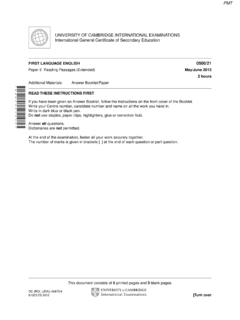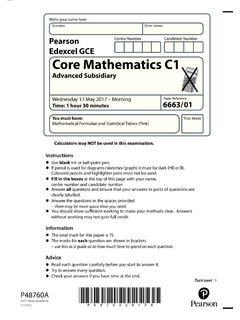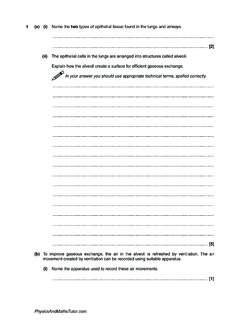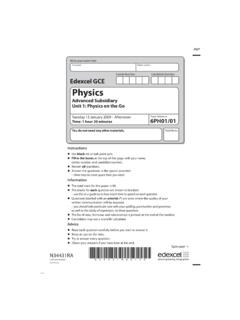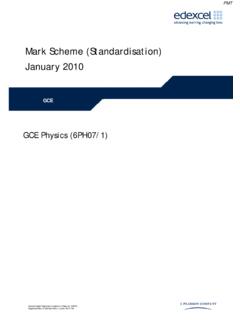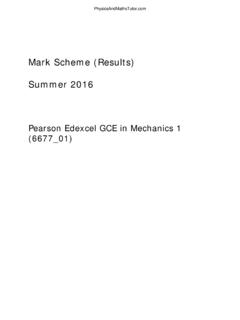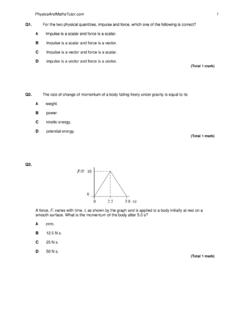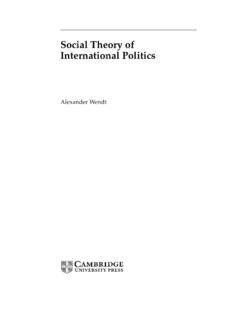Transcription of UNIVERSITY OF CAMBRIDGE INTERNATIONAL …
1 This document consists of 17 printed pages and 3 blank pages. IB10 06_0610_31/4RP UCLES 2010 [Turn over *0409173684*For Examiner's Use 1 2 3 4 5 6 Total UNIVERSITY OF CAMBRIDGE INTERNATIONAL EXAMINATIONS INTERNATIONAL General Certificate of Secondary Education BIOLOGY 0610/31 Paper 3 Extended May/June 2010 1 hour 15 minutes Candidates answer on the Question Paper. No Additional Materials are required. READ THESE INSTRUCTIONS FIRST Write your Centre number, candidate number and name on all the work you hand in. Write in dark blue or black pen. You may use a pencil for any diagrams or graphs. Do not use staples, paper clips, highlighters, glue or correction fluid. DO NOT WRITE IN ANY BARCODES. Answer all questions. At the end of the examination, fasten all your work securely together. The number of marks is given in brackets [ ] at the end of each question or part question.]
2 PMT2 UCLES 2010 0610/31/M/J10 For Examiner's Use 1 (a) Define the term sensitivity. [2] Fig. shows a horizontal section through the eye. XYABCDE Fig. (b) (i) Name structures A to D. A B C D [4] (ii) State the functions of structures B and E. B E [2] PMT3 UCLES 2010 0610/31/M/J10 [Turn over For Examiner's Use The retina contains light-sensitive cells known as rods and cones. The distribution of rods in the retina from point X to point Y, as shown on Fig. , was investigated. Fig. shows the distribution of rods in the retina from point X to point Y. numberof light-sensitivecellsXGHY distance along the retina Fig. (c) (i) G and H, as shown on Fig. , are parts of the retina. Name G and H. G H [2] (ii) Describe the function of the rods. [2] (iii) Draw a line on Fig. to show the distribution of cones in the retina. [2] [Total: 14] PMT4 UCLES 2010 0610/31/M/J10 For Examiner's Use 2 A student measured the uptake and release of carbon dioxide from a plant during 24 hours.]
3 It was a very bright, sunny day between sunrise and sunset. Fig. shows the student s results. 000006001200time / h18002400uptake ofcarbondioxiderelease ofcarbondioxideno netuptakeor release Fig. (a) (i) Use the information in Fig. to state the time that sunrise occurred. [1] (ii) Using Fig. , state the times when there is no uptake or release of carbon dioxide. 1. 2. [1] (iii) State why plants release carbon dioxide at night. [1] (iv) Explain why it is important for plants that carbon dioxide uptake during the day is greater than carbon dioxide released at night. [2] PMT5 UCLES 2010 0610/31/M/J10 [Turn over Question 2 continues on Page 6 PMT6 UCLES 2010 0610/31/M/J10 For Examiner's Use The yields of tomatoes grown in open fields in India are very low compared with yields of tomatoes grown in glasshouses in Europe. In a study, scientists in India grew tomato plants in glasshouses and in open fields nearby.]
4 The growth of the plants and the yields of tomatoes were recorded. The results are shown in Table Table tomato plants grown in glasshouses open fields mean final height of tomato plants / cm mean number of leaves per tomato plant mean fresh mass of tomato plants / g mass of tomatoes per plant / g mean fresh mass of tomatoes / g (b) (i) The mean fresh mass of tomatoes grown in glasshouses was greater than the mean fresh mass of tomatoes grown in open fields. Calculate the difference in mean fresh mass as a percentage of the mean fresh mass of tomatoes grown in open fields. Show your working. Answer = % [2] PMT7 UCLES 2010 0610/31/M/J10 [Turn over For Examiner's Use (ii) Suggest how an increase in the height of the plants and the number of leaves on each plant affects the yield of tomatoes.]
5 [3] (c) The scientists made sure that the only differences between the two groups of plants were the result of the protection provided by the glasshouses. Suggest the factors that the scientists should have kept the same for the two groups of plants in this investigation. [3] (d) The growth and final yields of crops grown in open fields are often limited by environmental factors. Describe how these factors are controlled in commercial glasshouses to give high yields of crops such as tomatoes. [4] [Total: 17] PMT8 UCLES 2010 0610/31/M/J10 For Examiner's Use 3 Fig. shows a human egg cell and a human sperm cell. 10 mhuman sperm cellhuman egg cell100 m Fig. (a) (i) What is the name given to the release of eggs from the ovary? [1] (ii) Sperm cells and egg cells are haploid. State the meaning of the term haploid. [1] PMT9 UCLES 2010 0610/31/M/J10 [Turn over For Examiner's Use (b) Complete the table to compare egg cells with sperm cells.]
6 Feature egg cells sperm cells site of production relative size numbers produced mobility [4] (c) Three hormones that control the menstrual cycle are: follicle stimulating hormone (FSH) luteinising hormone (LH) oestrogen. (i) Name the site of production and release of oestrogen. [1] (ii) Describe the role of oestrogen in controlling the menstrual cycle. [2] (d) Artificial insemination is sometimes used as a treatment for female infertility. Outline how artificial insemination is carried out in humans. [2] [Total: 11] PMT10 UCLES 2010 0610/31/M/J10 For Examiner's Use 4 Acid rain is a serious environmental problem in some areas of the world. Lakes in Canada, Norway and Scotland are highly acidic as a result of acid rain. Fig. shows a cause of acid rain. power stations andfactories releasesulfur dioxiderain becomes acidicharming vegetationand organisms thatlive in waterwind-blown chemicalscombine with watervapour in the airlake Fig.
7 (a) (i) State one cause of acid rain other than that shown in Fig. [1] (ii) Describe two effects of acid rain on forest ecosystems. 1. 2. [2] (b) Describe two different ways to reduce pollution so that there is less acid rain. 1. 2. [2] PMT11 UCLES 2010 0610/31/M/J10 [Turn over For Examiner's Use Fig. shows the pH ranges that some animals that live in lakes can tolerate. troutbassperchfrogssalamandersclamssnail scrayfishmayfly larvaeblackfly Fig. (c) State one feature of molluscs that is not a feature of crustaceans. [1] (d) Using the information in Fig. , (i) name an animal that could be found in a lake with a pH of ; [1] (ii) name the animals that are most sensitive to a decrease in pH; [1] (iii) suggest why some animals cannot tolerate living in water of pH as low as [2] [Total: 10] PMT12 UCLES 2010 0610/31/M/J10 For Examiner's Use 5 Fig. shows the processes involved in the manufacture of yoghurt.]
8 Milkmilk heat treated at 85 95 C for 15 to 30 minutesmilk homogenised to give an even consistencystarter culture of bacteria addedmixture incubated at 37 44 Cmixture cooledyoghurt is packed and sent at 4 C to shopssugar may be addedfood additives and fruit addedmilk cooledoxygen used uppH decreases Fig. (a) (i) Explain why the milk must be cooled before the bacteria are added. [2] (ii) Explain why the pH decreases only after the oxygen in the milk has been used up. [2] (iii) Suggest one type of food additive that could be added to yoghurt. [1] PMT13 UCLES 2010 0610/31/M/J10 [Turn over For Examiner's Use The starter culture contains two species of bacteria, Streptococcus thermophilus and Lactobacillus bulgaricus. Fig. shows the growth of these bacteria during the production of yoghurt. 0123time since start of incubation / h456numbers ofbacteriaS. thermophilusL. bulgaricus Fig. (b) Using your knowledge of population growth and the factors that affect it, describe and explain the growth of S.]
9 Thermophilus, as shown in Fig. [5] PMT14 UCLES 2010 0610/31/M/J10 For Examiner's Use (c) Suggest why the numbers of L. bulgaricus do not start to increase until after the increase in the numbers of S. thermophilus. [2] [Total: 12] PMT15 0610/31/M/J10 [Turn over BLANK PAGE Question 6 begins on page UCLES 2010 0610/31/M/J10 For Examiner's Use 6 The Food and Agriculture Organization (FAO) collects data on food supplies worldwide. The FAO classifies the causes of severe food shortages as either by natural disasters or as the result of human action. Natural disasters are divided into those that occur suddenly and those that take a long time to develop. Human actions are divided into those that are caused by economic factors and those that are caused by wars and other conflicts.]
10 Fig. shows the changes in the number of severe food shortages between 1981 and 2007. 1981 1983 1985 1987 1989 1991 1993 1995 1997 1999 2001 2003 2005 2007totalnaturaldisastersresult ofhumanaction706050403020100yearnumberof severefoodshortages Fig. PMT17 UCLES 2010 0610/31/M/J10 [Turn over For Examiner's Use Fig. shows the causes of severe food shortages in the 1980s, 1990s and 2000s. naturaldisastersresult ofhumanactionkeysudden onseteconomic factorsslow onsetwar and conflict1980s1990s2000s86 %80 %73 %1414 %2020 %2727 %14 %2 %20 %27 %1111 %9898 %8989 %7373 %2727 %11 %27 %98 %89 %73 % Fig. (a) (i) State two types of natural disaster that occur suddenly and may lead to severe food shortages. 1. 2. [2] (ii) State one type of natural disaster that may take several years to develop. [1] PMT18 UCLES 2010 0610/31/M/J10 For Examiner's Use (b) Use the information in Fig. and Fig. to describe the changes in food shortages between 1981 and 2007.]
